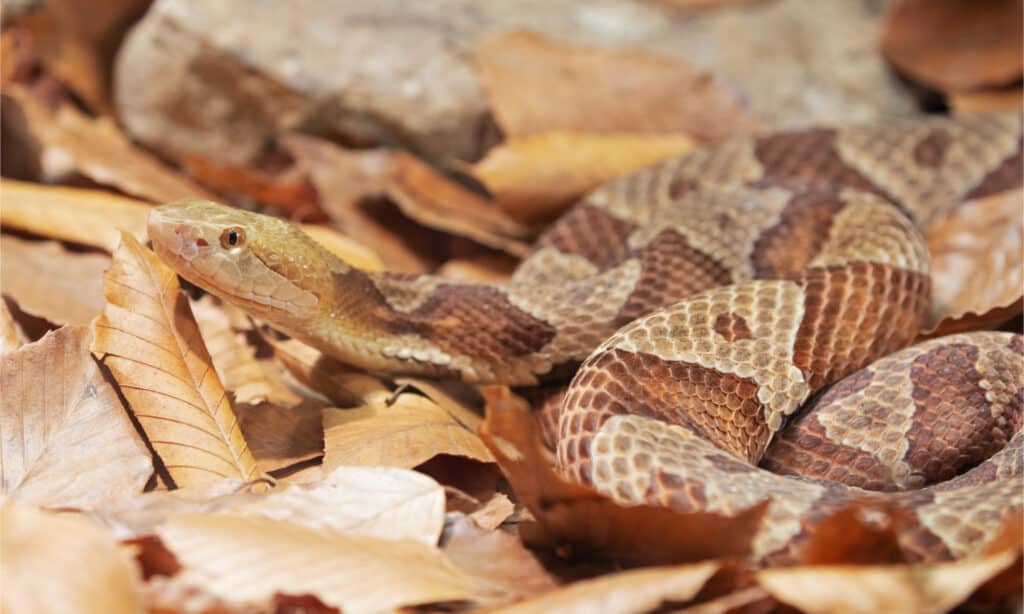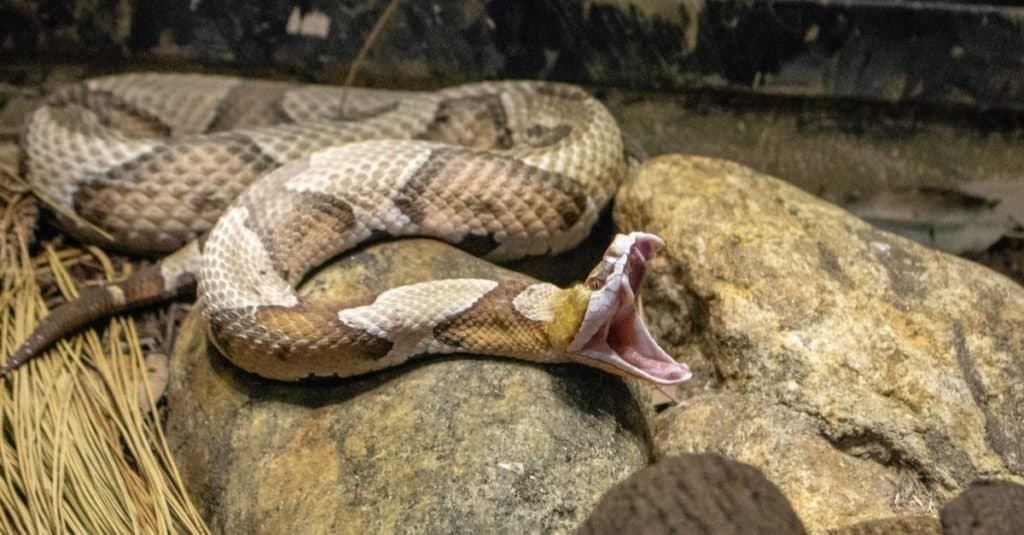Florida is well-known for its sunny climate and stunning scenery. However, it also has a vast and diverse range of habitats, from the Everglades to its numerous barrier islands. They are the perfect place for a wide variety of animals to live — including snakes. Florida is home to a massive 44 species of snakes, and six of them are venomous. So, let’s learn about about the venomous copperheads in Florida, including when they are most active, where they live, what they look like, and how to avoid them.
About Copperheads

Copperheads have distinctive pinkish-colored bodies with hourglass-shaped markings.
©Jeff W. Jarrett/Shutterstock.com
There originally used to be five subspecies of copperheads — northern, southern, broad-banded, Trans-Pecos, and Osage. However, these have since been reclassified into two distinct species. The broad-banded and Trans-Pecos subspecies have been reclassified as the broad-banded copperhead (Agkistrodon laticinctus), while the remaining subspecies are now identified as the eastern copperhead (Agkistrodon contortrix). Eastern copperheads are the species which occur in Florida.
Eastern copperheads, often known simply as copperheads, are medium-sized snakes which range between 20 and 37 inches long. They have a broad head and heavy body with keeled dorsal scales. Copperheads have a distinctive light to pinkish-tan ground color which is overlaid with approximately 10 to 18 crossbands. The crossbands are dark to reddish-brown with paler-coloured centers. They often become divided at the center of the back to produce a noticeable hourglass-shape. Juvenile copperheads have a very similar appearance to adults. However, they can be distinguished by their bright yellow tail tip.
Where Do Copperheads in Florida Live?

Copperheads typically inhabit hardwood and upland pine forests in Florida.
©DnDavis/Shutterstock.com
Copperheads have a limited range within Florida. They only inhabit the Panhandle region — specifically in the western region and the area around the Apalachicola River and its tributaries. In fact, the only counties with confirmed records of copperheads are Calhoun, Escambia, Gadsden, Jackson, Liberty, Okaloosa, and Santa Rosa.
Copperheads live in a wide variety of habitats, but in Florida they tend to live in hardwood and upland pine forests. They prefer places with plenty of leaf litter and areas with logs and rocks that they can use as shelter. However, they can also sometimes be found in areas bordering swamps, rivers, and in damp ravines.
Copperheads prey on a wide range of animals that they can find in their preferred habitat. However, adults prey more heavily on small mammals such as rodents, while juveniles prefer smaller prey such as insects, frogs, and salamanders. In fact, they often use their colorful tail to attract their prey to them!
When Are Florida Copperheads Most Active?
Copperheads can be either nocturnal or diurnal, depending on the weather. They are most active at night during hot weather so they can avoid the full heat of the sun. However, during cooler periods in the spring and fall they become active during the daytime. Despite this, they are typically only active between March and November in Florida as they enter brumation during the winter months. During this period, copperheads live in dens or crevices with other snakes — often timber rattlesnakes and rat snakes. However, it’s important to remember that brumation is not the same as hibernation, so copperheads can still come outside during this period. In fact, it’s not unusual to see them basking outside on warm afternoons.
Florida copperheads are also usually more active during the mating season. This occurs in the spring, and as the males pursue the females they will often engage in “combat dances” as they compete for breeding rights with her. The combat dance is an elaborate display where the males lift their bodies up off the ground and entwine with each other in an attempt to topple their opponent.
Copperheads are ovoviviparous. This means that the females retain their eggs inside their body until they hatch, then giving birth to live young. The juvenile snakes are born in the late summer and early fall. They are typically only eight inches long and most litters consist of only four to eight snakes.
How Dangerous are Copperheads?

Copperheads are responsible for more snake bites in the US than any other venomous snake.
©Suzanna Ruby/Shutterstock.com
Copperheads are venomous snakes and are regarded as being responsible for more snake bites than other venomous snakes in the US. Approximately 7,000 to 8,000 bites occur in the US as a result of venomous snakes every year. It is estimated that around 2,920 of these are caused by copperheads. However, copperheads are not the most dangerous snake in Florida. They have a maximum venom yield of approximately 85mg, although the average is only 26mg. For reference, the estimated lethal dose for a human is 80 to 100mg. Therefore, although bites from these snakes are painful, they are rarely fatal for healthy adults.
Copperheads possess hemotoxic venom which damages the tissue and red blood cells in the area surrounding the bite. This causes localized swelling, tissue damage, necrosis (tissue death), and circulatory damage. Although not as deadly as some of the other types of venom, this can be extremely painful and can lead to serious scarring of the tissue in the affected area. Copperhead bites should always be taken seriously, though, and the victim should always seek immediate medical help. For the best outcome, anti-venom needs to be administered within two hours of the bite occurring.
What to Do if You See a Copperhead
Most copperhead bites are a direct result of the snake being disturbed or accidentally stood on. Copperheads have excellent camouflage and are difficult to see in the leaf litter anyway, but are often virtually impossible to spot when they are hidden underneath logs or rocks. Therefore, the best way to avoid being bitten is to be extremely careful where you walk. Also, never reach under logs or put your hands into crevices.
If you do come across a copperhead then the snake is likely to initially freeze and flatten their body against the ground. They may also release a strong-smelling musk in an attempt to ward off the threat. Copperheads can also sometimes vibrate the tip of their tail in the leaf litter in a motion which replicates the sound of a rattlesnake. They will typically only strike as a last resort, so if you do see one of these snakes then the most important thing you should do is move away slowly and give the snake a wide berth.
The photo featured at the top of this post is © Creeping Things/Shutterstock.com
Discover the "Monster" Snake 5X Bigger than an Anaconda
Every day A-Z Animals sends out some of the most incredible facts in the world from our free newsletter. Want to discover the 10 most beautiful snakes in the world, a "snake island" where you're never more than 3 feet from danger, or a "monster" snake 5X larger than an anaconda? Then sign up right now and you'll start receiving our daily newsletter absolutely free.
Thank you for reading! Have some feedback for us? Contact the AZ Animals editorial team.






